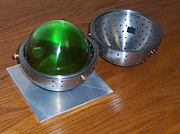- Number 326 |
- December 6, 2010
Radiation mapping device scans hazardous environments remotely
A partnership that stretches “across the pond” between DOE’s Savannah River National Laboratory (SRNL) and the United Kingdom’s National Nuclear Laboratory (NNL) aims to reduce worker exposure by providing technology to remotely perform the characterization needed for deactivation and decommissioning (D&D) of radioactively contaminated facilities in both the U.S. and the U.K. This collaborative effort is taking an innovative original idea, with each party’s additions resulting in a transformational and continuously more useful product.
The partnership was established to test, underpin, and strengthen the technical performance of NNL’s remote, nonelectrical, radiation-mapping device known as RadBall™ (patent pending), which offers a means to locate and quantify gamma radiation levels within areas where human occupancy is not safe. Positive results from initial deployment trials in the U.K.’s nuclear waste reprocessing plants at Sellafield and the anticipated future potential use of RadBall throughout the U.S. DOE Complex led the EM Office of Deactivation & Decommissioning/Facility Engineering to fund to a successful testing program at SRNL, along with SRNL’s development of accessories for future RadBall™ deployment.
“When you’re planning D&D activities in contaminated facilities, one of the critical first steps involves developing an accurate assessment of the radiological, chemical, and structural conditions inside of the facilities,” says SRNL’s Manager of Environmental Analysis John Gladden. “For facilities that involve high hazards, the use of remote and robotic technologies for characterization can be a very cost-effective way to reduce employee exposure.” A low cost, robust, remotely deployable tool for 3-D characterization would offer an inexpensive and safer means to perform initial radiological characterizations, in-process surveys, and final status surveys to enable effective decontamination while minimizing exposures to workers.
A single RadBall can be positioned in a highly contaminated area, glove box, or hot cell and left alone to passively collect data instead of personnel spending valuable time and potential exposure carrying out manual scanning and surveying. The device consists of a colander-like outer shell that houses a baseball-sized sphere made of a radiation-sensitive polymer. The outer shell works to collimate radiation sources; those areas of the polymer sphere that are exposed react to the radiation, becoming increasingly more opaque, in proportion to the absorbed dose. The direction of the opaque tracks in the ball shows the position of the source, and the change in the tracks’ opacity indicates the source’s activity. The polymer sphere is imaged in an optical-CT scanner developed at Duke University, which produces a high resolution 3D map that represents the absorbed dose.
The first set of tests was performed at the Savannah River Site’s Health Physics Instrument Calibration Laboratory (HPICL) using various gamma-ray sources and an x-ray machine with known radiological characteristics. These preliminary tests helped to identify the optimal dose and collimator thickness.
The second set of tests took place in SRNL’s Shielded Cells facility, where work with highly radioactive sources is performed. The objective of this testing was to use RadBall to characterize a hot cell that is highly contaminated with unknown radiation sources. First, the hot cell was characterized using common methods such as teledetectors and smears to determine the dose rates and radionuclides present. Then RadBalls were deployed in the hot cell to obtain a comprehensive 3D characterization, and the results from the characterization methods were compared.
This test represented the first successful hot cell deployment of the RadBall. In this test, RadBall located the strongest radiation doses originating from the floor of the hot cell, and the location of these radiation sources was displayed on a 3D visualization of the hot cell.
RadBall™ can be deployed in different ways depending on the size and characteristics of the contaminated area. Some areas might have a crane and/or hand manipulators. Other deployments might include highly contaminated rooms with limited access and/or visibility, where remote control devices with sensor and video equipment might be required. SRNL has been designing RadBall accessories for these types of deployments. These include a harness for future RadBall deployments into hot cells where a crane or manipulator is available.
Since RadBall is a passive radiation detection device and contains no electronics, it cannot determine its location or orientation within a contaminated room. SRNL has been developing a proof of concept Position and Orientation Determination System (PODS-patent pending) that will determine the RadBall's location and orientation within a room. Data from this system can be used along with the RadBall data in order to map the detected radiation spots onto the walls, floor and ceiling.
Future milestones involve the testing of a robot for remote RadBall deployment into highly
contaminated facilities, portable optical CT scanner development for field deployment, and RadBall deployment at another DOE facility using the robot and portable scanner to promptly obtain visualizations of the contaminated hot cell or glove box. Further software and visualization development will also take place to provide an enhanced output image to better visually interpret the sources of radiation in the deployed environment.
Submitted by DOE's Savannah River National Laboratory

